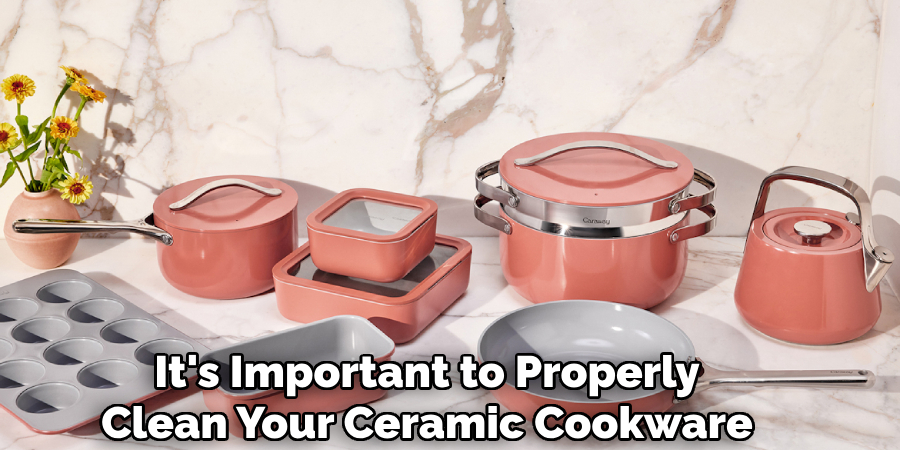Ceramic cookware has become a popular choice in kitchens around the world due to its versatility, aesthetic appeal, and non-toxic properties. Its ability to distribute heat evenly makes it ideal for a wide range of cooking techniques, from sautéing to baking. Additionally, ceramic cookware is known for its non-stick surface, which promotes healthier cooking by reducing the need for excessive oils or fats.

Whether you’re a seasoned chef or a beginner in the kitchen, understanding how to properly use and care for ceramic cookware can help you get the most out of your meals while ensuring the longevity of your pots and pans.
In this article on how to use ceramic cookware, we’ll cover the basics of cooking with ceramic and provide some helpful tips for cleaning and maintaining your cookware.
Types of Ceramic Cookware
Ceramic cookware comes in a variety of forms to suit different cooking needs. Here are some of the most common types:
Ceramic-Coated Cookware
This type features a metal base, usually aluminum or stainless steel, coated with a layer of ceramic. It is lightweight, heats up quickly, and is ideal for everyday cooking like sautéing or frying.
Solid Ceramic Cookware
Made entirely of ceramic, this cookware is often heavier and more durable. It is great for slow cooking, baking, and preparing soups or stews due to its excellent heat retention properties.
Ceramic Bakeware
Specifically designed for oven use, ceramic bakeware includes items like casserole dishes, pie pans, and ramekins. This type of cookware ensures even cooking and is perfect for baked goods and hearty casseroles.
Ceramic Dutch Ovens
These are versatile and durable, suitable for tasks like roasting, braising, or simmering. They are built to withstand high temperatures and offer a stylish, rustic appearance.
Ceramic Woks and Specialty Pans
For those who enjoy diverse cuisines, ceramic woks and griddles offer a non-stick and healthy cooking surface perfect for stir-frying, grilling, or cooking pancakes.
Each type has its own strengths and is designed for specific cooking functions, making it easy to find the perfect ceramic cookware for your kitchen needs.
Needed Materials
Ceramic Wok or Griddle:
Choose a high-quality, well-constructed ceramic wok or griddle with a durable non-stick surface for easy cooking and cleaning.
Wooden or Silicone Utensils:
To prevent scratching the ceramic surface, use wooden or silicone utensils when cooking.
Heat-resistant Gloves:
Since ceramic cookware can get very hot, heat-resistant gloves are essential for safety while handling it during cooking and cleaning.
Dish Soap and Soft Sponge:
To clean your ceramic cookware properly, use a mild dish soap and a soft sponge. Avoid using harsh abrasives or metal scrubbers as they can damage the surface.
Baking Soda:
Baking soda is not only great for baking but also for removing tough stains on your ceramic cookware. Mix it with water to create a paste and gently scrub away any stains before washing with dish soap.
White Vinegar:
For extra stubborn stains, soak your ceramic cookware in white vinegar and hot water overnight before scrubbing with baking soda.
7 Step-by-Step Guidelines on How to Use Ceramic Cookware
Step 1: Choose the Right Size
Select a ceramic wok or griddle that suits your cooking needs and the number of servings you plan to prepare. For smaller meals or single servings, a compact size will work efficiently.

However, if you’re cooking for a family or hosting guests, opt for a larger piece to ensure ample cooking space and even heat distribution. Using the right size cookware helps maintain proper cooking functionality and avoids overcrowding, which can compromise the results.
Step 2: Preheat the Cookware
Before adding any ingredients, it’s essential to preheat your ceramic cookware to ensure even cooking. This step is especially crucial for recipes that require high heat or quick cooking times. Place the wok or griddle on a stove burner and turn the heat to medium-high.
Allow the cookware to heat up for a few minutes until it’s evenly hot.
Step 3: Add Oil
Ceramic cookware requires less oil than traditional pots and pans due to its non-stick surface. However, adding a small amount of oil can enhance the flavor of your dish and prevent food from sticking.
Use a high smoke point oil like vegetable, canola, or peanut oil for best results. Avoid using olive oil or butter as they have lower smoke points and may burn easily.
Step 4: Prepare Your Ingredients
While your ceramic cookware is heating, take this time to prepare your ingredients. Ensure vegetables are washed, meats are properly seasoned, and all components are ready for cooking.
Having your ingredients prepped and within reach allows for a smoother cooking process and prevents delays, ensuring that your food cooks evenly and at the right temperatures.

Step 5: Start Cooking!
Once your cookware is heated and your ingredients are prepped, it’s time to start cooking! Use a wooden or silicone utensil when stirring or flipping food in ceramic cookware to avoid scratching the surface.
Cook your dish according to the recipe instructions, adjusting heat as needed to prevent burning.
Step 6: Clean Up
After enjoying your meal, it’s important to properly clean your ceramic cookware to maintain its quality. Allow the cookware to cool completely before washing to prevent cracking or warping. Use warm, soapy water and a soft sponge or cloth to gently clean the surface. Avoid abrasive scrubbers or harsh chemicals, as these can damage the ceramic coating.
For stubborn food residue, soak the cookware in warm, soapy water for a few minutes before cleaning. Once washed, thoroughly dry the cookware to prevent water spots and ensure it is ready for your next cooking session. Proper care will keep your ceramic cookware in great condition for years to come.
Step 7: Let It Rest
After your dish is cooked, it’s important to let it rest for a few minutes before serving or putting away leftovers. This allows the flavors to fully develop and prevents hot spots in the food that could burn your mouth. Covering the dish with foil or a lid can help retain heat while it rests.
Following these steps on how to use ceramic cookware and properly caring for your cookware will ensure delicious and successful meals every time. Experiment with different recipes and techniques to fully utilize the benefits of ceramic cookware in your kitchen. Happy cooking!

Additional Tips for Using Ceramic Cookware
- Avoid using metal utensils on ceramic surfaces as they can cause scratches.
- Use low to medium heat when cooking with ceramic cookware to prevent discoloration or warping.
- Allow the pan to cool down before washing it to avoid thermal shock, which can damage the ceramic coating.
- Don’t use abrasive cleaners or scouring pads on ceramic cookware as they can scratch the surface.
- Store your ceramic cookware carefully, making sure that the pieces do not rub against each other, which can also cause scratches.
- Consider investing in ceramic cookware with a non-stick coating for easier cleaning and healthier cooking with less oil or butter needed.
Frequently Asked Questions
Q1: Can I Use Metal Utensils With Ceramic Cookware?
A: No, it is not recommended to use metal utensils with ceramic cookware as they can scratch and damage the surface. Instead, opt for wooden, silicone or nylon utensils. The same applies for cleaning, avoid using harsh scrubbers or abrasive cleaners.
Q2: Is Ceramic Cookware Safe?
A: Yes, ceramic cookware is considered safe as long as it is used and maintained properly. Some ceramic coatings may contain chemicals like PTFE and PFOA, so be sure to check the label before purchasing. It is also important not to overheat the cookware or use it on high heat settings to prevent any potential health risks.
Q3: How Do I Clean My Ceramic Cookware?
A: To clean your ceramic cookware, let it cool down first before washing it with warm soapy water and a soft sponge. Avoid using metal scrubbers as it can scrape off the ceramic coating.
For tough stains, you can soak the cookware in a mixture of baking soda and water before gently scrubbing it off. It is also important to avoid using harsh chemicals or abrasive cleaners as they can damage the ceramic coating.

Q4: What Should I Avoid When Using Ceramic Cookware?
A: When using ceramic cookware, it is important to avoid exposing it to sudden temperature changes. This means avoiding placing a hot pan directly under cold water or placing it in a preheated oven.
It is also recommended to avoid using metal utensils while cooking in ceramic cookware, as they can scratch or damage the coating. Additionally, acidic foods such as tomatoes and citrus fruits should be cooked with caution in ceramic cookware as they may react with the coating and cause discoloration.
Conclusion
In conclusion, ceramic cookware is an excellent choice for those seeking a safe and non-toxic cooking option. By following proper care and usage guidelines on how to use ceramic cookware, such as avoiding sudden temperature changes, using non-metal utensils, and being mindful of acidic ingredients, you can extend the lifespan of your cookware and maintain its performance.
With the right maintenance, ceramic cookware can provide both durability and a versatile cooking experience, making it a valuable addition to any kitchen.
Specialization:
- Master of wheel-throwing, hand-building, and advanced glazing techniques
- Focus on creating both functional pottery and decorative art pieces
Recognition:
- Celebrated by collectors and art enthusiasts for creating one-of-a-kind pieces that blend artistry with functionality
- Participates in local and national exhibitions, earning accolades for his innovative designs and craftsmanship
Passion:
- Deeply committed to exploring and pushing the boundaries of ceramic artistry
- Continuously experiments with new materials, firing techniques, and artistic concepts to evolve his craft
Personal Philosophy:
- Believes in the transformative power of art, aiming to evoke emotions and connections through his ceramic creations
- Advocates for sustainability in ceramics, using eco-friendly materials and practices whenever possible


